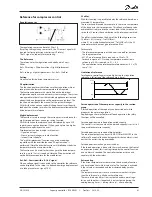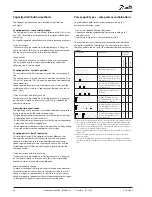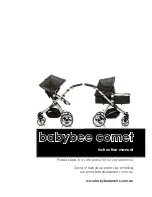
82
Capacity
controller RS8ER302 © Danfoss 2016-02
AK-CH
650
Capacity distribution methods
The capacity distributor can work based on 3 distribution
principles.
Coupling pattern – sequential operation:
The compressors are cut in and cut-out following the “First in, Last
out” (FILO) principle in accordance with the sequence defined in
the set-up.
Any speed-regulated compressors are used to close capacity gaps.
Timer restrictions
If a compressor is prevented from starting because it “hangs” on
the re-start timer, this step is not replaced by another compressor
but the step switch waits until the timer has lapsed.
Safety cutout
If on the other hand there is a safety switch on this compressor,
this is excluded and the step switch immediately selects the
following step in the sequence.
Coupling pattern – Cyclical operation:
This principle is used if all compressors are of the same type and
size.
The compressor cuts-in and cuts-out in accordance with the "First
In First Out" principle (FIFO) to equalise operating hours between
the compressors.
Speed-regulated compressors will always be cut in first, and the
variable capacity is used to fill capacity gaps between the subse-
quent steps.
Timer restrictions and safety cut outs
If a compressor is prevented from starting because it is “hanging”
on the restart timer or is safety cut out, this step is replaced by
another compressor.
Operating time equalisation
The operating hour equalizing is carried out between compressors
of the same type with the same total capacity.
-At the different startups the compressor with the lowest number
of operating hours will be started first.
- At the different stops the compressor with the highest number of
operating hours will be stopped first.
- For compressors with several steps, the operating time equalizing
is carried out between the compressors’ main steps.
Coupling pattern – Best fit operation
This principle is used if the compressors are of different sizes.
The capacity distributor will cut-in or cut-out the compressor
capacity in order to ensure the least possible capacity jump.
Speed-regulated compressors will always be cut in first, and the
variable capacity will be used to fill capacity gaps between the
subsequent steps.
Timer restrictions and safety cut outs
If a compressor is prevented from starting because it is “hanging”
on the restart timer or is safety-cut out, this step is replaced by
another compressor or another combination.
Minimum capacity change
To prevent the capacity distributor from selecting a new compres-
sor combination (cut-out and cut-in compressors) due to a small
change in capacity requirements, it is possible to set a minimum
change in capacity requirement that will operate before the capac-
ity distributor changes to a new compressor combination.
Power pack types – compressor combinations
The controller is able to control power packs with up to 6
compressors of various types:
- One or two speed controlled compressor
- Capacity controlled reciprocating compressors with up to 3
unloader valves
- Single step compressors – reciprocating or scroll
The chart below shows the compressor combination which the
controller is capable of controlling. The chart also shows which
coupling pattern can be set for the individual compressor combi-
nations.
Combination
Description
Coupling
pattern
Sequenc
e
Cy
clical
Best fit
One-step compressors. *1
x
x
x
A compressor with an unload
valve, combined with one-step
compressors. *2
x
x
Two compressors with unload
valves, combined with one-step
compressors. *2
x
x
All compressors with unload
valves. *2
x
x
A speed-regulated compres-
sor combined with one-step
compressors. *1 and *3
x
x
x
A speed-regulated compressor
combined with several com-
pressors with unload valves. *2
and *3
x
x
Two speed-regulated compres-
sors combined with one-step
compressors *4
x
x
x
*1) For a cyclical coupling pattern, the one-step compressors must be the same size.
*2) For compressors with unload valves, it is generally true that they must have the
same size, the same number of unload valves (max 3) and the same sized main
steps. If compressors with unload valves are combined with one-step compres-
sors, all compressors should be the same size.
*3) Speed-regulated compressors can have different sizes in relation to subsequent
compressors.
*4) When two speed-regulated compressors are used, they must have the same
frequency range.
For cyclical coupling patterns, the two speed-regulated compressors should be
the same size and the subsequent one-step compressors should also be the same
size.
















































